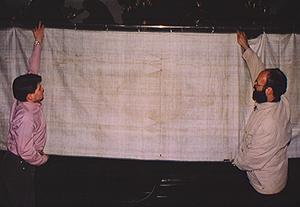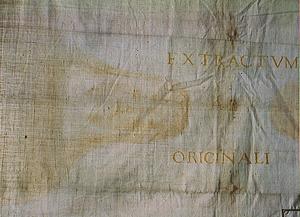The only problem is that your assertion is not true. There are copies of the Shroud that were made in the past... before photography... some within a few years of the first exposition. The Czechia Shroud Copy is an example that was found in a church in Broumov, Czzechia.

The 1651 Czechia Shroud Copy
Photograph copyright 1999 by Dr. Leo Bazant-Hegemark, image linked from Shroud.com

Close up of the 1651 Czechia Shroud.Note inscription:
"EXTRACTVM AB ORIGINALI" (Derived from the Original)
Photograph copyright 1999 by Dr. Leo Bazant-Hegemark, image linked from Shroud.com
Dr. Leo Bazant-Hegemark comments on the copy in his Report on the Czechia Shroud Copy:
The copy was found Jan. 18, 1999 by theol. scholar Premysl Sochor in the first balcony to the right in the monasterial church of Broumov, Czechia, hidden in a framed wooden box with a glass door, under the floor of the balcony (in a height of appr. 15m). With the linen was the authenticity, i.e., a letter of the archbishop of Turin, Bergiria, giving names, year and date (4 May 1651).
The artist who created this copy worked directly from the Shroud in Turin. It is obvious he was attempting to capture the evanescent, vaporish nature of the image on the Shroud. Dr. Bazant-Hegemark reports that the copy shows clear brush strokes and microscopic examination shows clear pigment particles. Negatives of the copy produce flat, unimpressive images that do not show a "positive" aspect. Of course, this copy is from 300 years after the first exposition in 1352.
A Shroud copy even closer in date, one that precedes the 1532 fire, is the Lier Shroud Copy... with a known provenance of 1516.

The 1516 Lier Shroud Copy
Photo linked from Imago Christi
The Imago Christi website gives a brief description of the Lier Copy:
A copy of the Shroud known as the "Lier Shroud" dated 1516 has at times been attributed to Albrecht Durer (1471-1528) and perhaps to the Flemish painter Bernard van Orley. This copy documents the fact that the Shroud has been through a fire at a time and in circumstances unknown, but certainly before the Chambery fire of 1532 -- it reproduces only the double mirror image series of little burn holes, visible in the Shroud today (shown in the photograph above). This copy (Lier Shroud) is located in Saint Gommaire Church of Lierre, Belgium."
Almost 150 years before the Czechia copy and 150 years after the original exposition of the Shroud, an artist attempts to capture the image on the Shroud in a dim, wispy painting that fails to duplicate the nature of the Shroud.
Here is another from 1624 by an artist not as skilled as the others, and possible a copy of a copy. Note the addition of a 'modesty cloth" around the loins:
